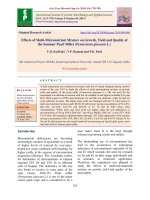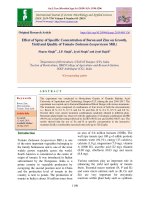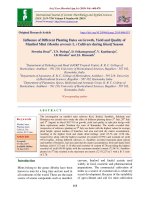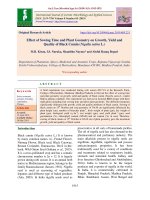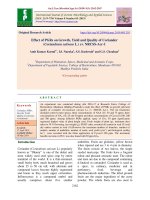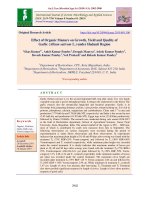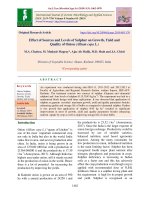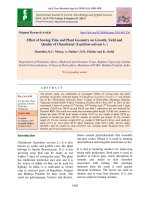Effects of several cultivation techniques on growth, development and quality of thanh ngoc orchid
Bạn đang xem bản rút gọn của tài liệu. Xem và tải ngay bản đầy đủ của tài liệu tại đây (2.17 MB, 104 trang )
VIET NAM VIETNAM NATIONAL UNIVERSITY OF AGRICULTURE
FACULTY OF AGRONOMY
UNDERGRADUATE THESIS
TOPIC: EFFECTS OF SEVERAL CULTIVATION
TECHNIQUES ON GROWTH, DEVELOPMENT AND
QUALITY OF THANH NGOC ORCHID
(CYMBIDIUM SINENSE)
Name
: DANG THI PHUONG ANH
Student code
: 611573
Class
: K61KHCTT
Instructor
: ASSOC.PROF. NGUYEN VIET LONG
Department
: FOOD CROP SCIENCE
HANOI – 2021
COMMITMENT
I hereby declare that this is my own research, the data and research results
in this report are truthful and have not been used to defend a degree.
I hereby certify that all assistance in the implementation of this graduate
research project has been thanked and the information cited has been indicated
by the origin, name of the author, time of publication.
Ha Noi, February 25th, 2021
Student
Đặng Thị Phương Anh
i
ACKNOWLEDGEMENTS
This page is where I would like to thank all those who helped me with my
project thesis: “Effects of several cultivation techniques on growth,
development and quality of Thanh Ngoc orchid (Cymbidium sinense)”
Foremost, I would like to express my sincere gratitude to my advisor
Associate Professor Nguyen Viet Long, for the continuous support of my study,
research and experimental, for his patience, motivation, enthusiasm, and
immense knowledge. His guidance helped me in all the time of research and
writing of this thesis. I could not have imagined having a better advisor and
mentor for my undergraduate thesis study.
Besides my advisor, I would like to thank Associate Professor Dang Van
Dong, Fruit and Vegetable Research Institute for helping me a lot during the
experiment time!
Also, I thank my friends, who helped me over the time, and I undoubtedly
could not have done this without them.
Last but not the least, I would like to thank my family: my parents for
giving birth to me at the first place and supporting me.
Hanoi, February 25th , 2021
Student
Đặng Thị Phương Anh
ii
CONTENT
COMMITMENT .................................................................................................... i
ACKNOWLEDGEMENTS .................................................................................. ii
LIST OF TABLES ................................................................................................ v
LIST OF FIGURE ................................................................................................ vi
LIST OF PICTURES .......................................................................................... vii
UNDERGRADUATE THESIS SUMARY ....................................................... viii
CHAPTER 1: INTRODUCTION ...................................................................... 1
1.1 Rationale.......................................................................................................... 1
1.2 Objective ......................................................................................................... 2
CHAPTER 2: LITERATURE REVIEW.......................................................... 3
2.1. An overview of Thanh Ngoc orchid (Cymbidium sinense) ........................... 3
2.1.1 Origin and classification of orchid ............................................................... 3
2.1.2. Morphological characteristics and ecological conditions of Thanh Ngoc
orchid (Cymbidium sinense) .................................................................................. 3
2.2. The scientific basis for orchid flowering ....................................................... 7
2.3 Production situation of orchids in the world and in Vietnam ....................... 10
2.3.1 Production situation of orchids in general and Thanh Ngoc in particular in
the world .............................................................................................................. 10
2.3 Production and consumption of orchids in the country ................................ 13
2.4. Research situation Thanh Ngoc orchid (Cymbidium sinense) ..................... 17
2.4.1. Research in the world ................................................................................ 17
2.4.2 Research in Vietnam .................................................................................. 18
CHAPTER 3: MATERIAL AND METHOD ................................................. 21
3.1. Material and research object ........................................................................ 21
3.2. Research place and time ............................................................................... 21
3.3. Research content .......................................................................................... 22
3.4. Research method .......................................................................................... 22
iii
3.5. Data collection.............................................................................................. 27
3.6. Data analysis ................................................................................................ 28
CHAPTER 4: RESULTS AND DISCUSSION .............................................. 29
4.1. Effect of substrate on yield and quality of Thanh Ngoc orchid ................... 29
4.2. Research to determine the appropriate fertilizer for Thanh Ngoc orchid at
the mature stage ................................................................................................... 33
4.3. Effects of irrigation water on the growth and development of Thanh Ngoc
orchid ................................................................................................................... 40
4.4. Effect of shading mode on yield and quality of Thanh Ngoc orchid ........... 42
4.5. Influence of treatment time on flowering rate and flower quality of Thanh
Ngoc orchid ......................................................................................................... 49
CHAPTER 5. CONCLUSION AND RECOMENDATION ......................... 52
5.1. Conclusion .................................................................................................... 52
5.2. Recommendation .......................................................................................... 52
PART 6: REFERENCES .................................................................................. 53
APPENDIX ........................................................................................................ 58
iv
LIST OF TABLES
Table 2.1.
Global value for cut flowers (period 2014-2019) ........................ 10
Table 2.2.
Average annual prices at the Dutch flower auction (2014-2018)
(Euro cent/branch)........................................................................ 12
Table 4.1.
Influence of the substrate on the new branch height growth
dynamics of Thanh Ngoc orchid ................................................. 30
Table 4.2.
Influence of the substrate on growth and development
characteristic of Thanh Ngoc orchid ............................................ 32
Table 4.3.
Effects of fertilizer on Thanh Ngoc height growth dynamics. .... 35
Table 4.4.
Effects of some fertilizers on growth and development
characteristic of Thanh Ngoc orchid ........................................... 36
Table 4.5.
Effects of fertilizer on disease effection on Thanh Ngoc orchid . 38
Table 4.6.
Effects of irrigation water on some growth and development
characteristic of Thanh Ngoc orchid ........................................... 40
Table 4.7.
Effect of shading regime on some growth and development
characteristic of Thanh Ngoc orchid ........................................... 43
Table 4.8.
Influence of shade regime on flowering rate and flower quality of
Thanh Ngoc orchid in Gia Lam – Hanoi .................................... 46
Table 4.9.
The effects of shading on the disease situation on Thanh Ngoc orchid ... 48
Table 4.10.
Influence of the time taken to process on the time of Thanh
Ngoc's orchid appearance ............................................................ 49
Table 4.11.
Influence of the treatment time on flowering rate and flower
quality Thanh Ngoc...................................................................... 50
v
LIST OF FIGURE
Figure 4.1.
Influence of the substrate on the new branch height growth
dynamics of Thanh Ngoc orchid .................................................. 29
Figure 4.2.
Effects of fertilizer on Thanh Ngoc height growth dynamics. .... 35
Figure 4.3.
Effects of irrigation water on some growth and development
characteristic of Thanh Ngoc orchid ........................................... 41
vi
LIST OF PICTURES
Picture 4.1. Some substrate used in the experiment ............................................ 31
Picture 4.2. Some fertilizer used in experiment ................................................. 34
Picture 4.3. Effects of some fertilizers on the number of new branches/ pot ..... 37
Picture 4.4. Anthracnose in Thanh Ngoc orchid ................................................ 39
Picture 4.5. Measure the stem diameter .............................................................. 41
Picture 4.6. Measure the psedubulb diameter ..................................................... 41
Picture 4.7. Sunshade net systems....................................................................... 43
Picture 4.8. Difference color of leaves in CT2, CT3, CT4, CT5 ........................ 45
Picture 4.9. The flowering rate in CT4 ............................................................... 46
Picture 4.10. The flowering rate in CT1 ............................................................. 47
Picture 4.11. Thanh Ngoc orchid’s flower. ......................................................... 51
vii
UNDERGRADUATE THESIS SUMARY
The thesis is done in order to identify effects of cultivation techniques on
yield and quality of Thanh Ngoc orchid as well as contribute to supplement and
build the production process of this plant. The research includes 5 main
experiments done in 2 -year -old plant to access the effect of substrate, fertilizer,
irrigation water, lighting regime, and time of treatment on growth, development
and quality of Thanh Ngoc orchid. Most of them are designed in RBD type, 15
pots/ formula. Recorded data (for example, the number of new branches, leaves
length, leaves width, spike length, the number of flower/ spike,…) are analyzed
by Excel 2010, and Irristat application. These separate factors such as (i) The
substrate containing 1/3 pine bark + 1/3 peanut shell + 1/3 pebble stone, (ii)
Plant- Soul fertilizer (20-20-20) + TE ; (iii) Rainwater or well water with
medium EC value; (iv) Black nets to reduce 70% of direct light; (v) Treatment
of flowering in Moc Chau/ greenhouse for 5.5 months before Tet, are good for
growth, development and quality of Thanh Ngoc orchid.
viii
CHAPTER 1: INTRODUCTION
1.1 Rationale
For Vietnamese people, Thanh Ngoc orchid is a beautiful flower, easy to
care for, and does not require high technology to multiply or produce like some
other orchids. Growing orchids is not only a hobby to help people get in tune
with nature, but also a profession that brings a high source of economic income.
Thanks to favorable natural conditions, Vietnam is an ideal place to
develop orchids, especially indigenous orchids. Currently, in Vietnam, there are
many kinds of precious orchids such as Thanh Ngoc, Hoang Vu, Cam To, Thanh
Truong (Thai Ha et al., 2017), etc. Thanh Ngoc orchid is loved by many people, is
more appreciated than other orchid species because its long drooping leaves create
a soft, harmonious balance, the flowers are green and have a mild fragrance.
Cymbidium is a genus in the orchid family, the genus orchid has species
that stick on trees and is called Epiphytic cymbidium and there are species
growing on the soil, called the terrestrial orchid (Zhang et al., 2018) (Terrestrial
cymbidium). Enjoying and playing orchids, especially Cymbidium, has been
around for a long time in Vietnam. The people of Hanoi and the provinces of
Bac Ninh, Nam Dinh, Ha Tay (now Hanoi), Hung Yen, Thai Binh, ... have also
preserved many precious species of Cymbidium such as Thanh Ngoc, Hoang
Vu, Cam To, Thanh Truong,.. the value of each orchid pot is from a few million
to several tens of million dong when spring comes, thus bringing enormous
economic benefits.
With outstanding features, from 2015-2019, Thanh Ngoc orchid has been
collected, tested, and selected by the Fruit and Vegetable Research Institute in
the Northern provinces including Hanoi. Although this flower is evaluated as
healthy and suitable to the tastes of consumers, research on technical measures
to care for orchids is limited (Hanh et al., 2016), so the plant has poor growth
and productivity such as low quality of flowers, especially there is no way to
1
treat flowers to flower properly on Tet occasion. From the above fact, I
proceeded to implement the experiment: “Effects of several cultivation
techniques on growth, development and quality of Thanh Ngoc orchid
(Cymbidium sinense)”
1.2 Objective
- Identify effects of cultivation techniques (substrate, fertilizer, water,
shading mode, and flower treatment) on yield and quality of Thanh Ngoc orchid;
- Contribute to supplement and build the production process of Thanh
Ngoc orchid.
2
CHAPTER 2: LITERATURE REVIEW
2.1. An overview of Thanh Ngoc orchid (Cymbidium sinense)
2.1.1 Origin and classification of orchid
Robut Bron (1773 - 1858) was the first to have clearly distinguished
between orchid family and other families (Lack 2014). By 1836, John Lindley
(1779 - 1865) used the noun Orchid to refer to orchids and from then on the
orchids were classified into a family in a classification system called
Orchidaceae. He announced and arranged the cardboard of the orchid family
name and the name of the orchid family is used until today (Bessea et al., 2020).
In the flora classification system, Cymbidium of the orchid family
(Orchidaceae), orchid (Orchidales), subclass Maynoliophyta, (Liliopsida),
angiosperm (Angiospermatophyta), demarcation higher plants (Cosmobionia), flora
kingdom (Plantae). Currently, the genus Cymbidium has about 50-70 species,
distributed mainly in the south and east of Asia, the Malay archipelago, northern
and eastern Australia. However, the main distribution of this family is above
tropical latitudes, especially the Americas and Southeast Asia (Chace et al., 2015).
Origin of orchid (Cymbidium sinense) is in China and is scattered in some
Asian countries such as Vietnam, Korea, Japan, .... In Vietnam, this orchid genus
has many varieties of valuable orchids such as Mac Bien, Cam To, Hoang Vu, Tran
Mong, Thanh Ngoc, .. etc. The genus orchid genus (Cymbidium) has about 120
species, and in Vietnam there are 20 species (Averyanov et al., 2016). He has
identified 4 other species of orchid: Cymbidium eburneum Reichb; Cymbidium
erythraeum Lindl; Cymbidium floribundum Lindl; Cymbidium wilsonii Cook)
2.1.2. Morphological characteristics and ecological conditions of Thanh
Ngoc orchid (Cymbidium sinense)
* Ecological conditions:
- Temperature: Thanh Ngoc orchid is adapted to cool weather, grows and
develops well at 15 -250C, but can still live in low temperature conditions up to
3
50C and as high as 350C. The suitable temperature for growing is 18-250C, and
the flower germ differentiation temperature is 16-180C. In addition to the
requirement of average temperature, the difference in day and night temperature
also affects the growth and development of orchids. The larger difference is the
ideal condition for orchid growing because plants increase photosynthesis
during the day and decrease the intensity of respiration at night so more dry
matter accumulates in the plant (Zhang et al., 2018).
Humidity: Humidity is an important factor for the growth and
development of plants. If the humidity is too low, the plants will be stunted,
grow poorly, and the humidity is too high, creating an environment for fungal
diseases to grow (Smitamana et al., 2018). Thanh Ngoc orchid is suitable for 70
- 80% humidity.
Light intensity: Light affects the flowering of orchids. If there is a lack of
light, the plants will not flower, different orchids have different light
requirements. Orchids belong to the group of average photophilic orchids, the
need for light is about 50-70% of direct sunlight (De. L et al., 2020). According
to Bias 2019, in summer, orchids need to shade 50% of sunlight in summer, 1020% in winter for trees.
- Ventilation: According to Both (2017) ventilation is one of the important
ecological characteristics of orchids. Orchids rarely grow on the trees of the
upper layer and near the ground, because the upper layer is too strong and the
humidity is low, near the ground, the ventilation is poor and the humidity is
high, the middle layer with humidity, light. and moderate ventilation is suitable
for growing orchids. Especially in the seasons with high temperature and
humidity, ventilation plays a very important role, it helps plants dry quickly after
watering, so reducing the rate of disease spread.
4
* Morphological characteristics:
In morphology, Thanh Ngoc orchid is herbaceous, perennial, branching
every year to form small bushes.
- The underground body (also known as the base of the unit) is often short
to connect the bulbs together. The orchid tubers are actually short branches of
the onion. It is very short or elongated, it can be branched, leaf-bearing or not
leaf-bearing, on the stem there are nodes, each branch grows a leaf branch or
sheath leaf.
- Root orchid (practitioner): Thanh Ngoc orchid tubers are round. The
diameter of practitioner Thanh Ngoc is from 2-2.5 cm. Practitioner is
surrounded by the leaf sheaths staggered.
- Roots: Thanh Ngoc's root is a fleshy root, raw, fat, yellowish-white
inside, in the middle is a wood-fiber core. New roots usually only grow in
seedlings, while the mother plant seldom forms new roots, but only secondary
roots branching out of the tuberous roots.
- Leaf: Leaf in real form on the practitioner usually has petiole, between the
leaf sheath and the leaf stalk has a separating part, when the leaf blade falls,
there is still the sheath embracing the practitioner. The leaf tip is pointed, or
divided into two lobes. The leaf edge is serrated, the leaf tip is slightly curved.
The leaves are usually glossy green and smooth. The leaves are 55-65 cm long,
2-2.5 cm wide.
- Shoots / Branches: Flower buds grow from below of the practitioner from
the leaf axils, separating the old sheath and stabbing out, often appearing with
the stem buds. The stem buds are slightly flattened, the first leaves grow on both
sides of the fishtail, but the flower buds are more rounded and the enveloping
leaves are always tightly wrapped around the flower bud.
Thanh Ngoc orchid branches do not branch, can stand up or let go. The
length of the flower bed is from 30 cm to more than 80 cm. Flowers carry from a
5
few to several dozen flowers arranged alternately in a spiral line. Because the
number of flowers per flower is quite large, the flower size is quite large, so
Thanh Ngoc flower axis is often curved, when spreading out, still keep buds,
buds rotate in the direction of light during the day.
- Flower: The structure of the sword orchid consists of 3 outer petals of 3
sepals, with color and size almost similar to the 2 petals on the inside. And 1
other petal has the most distinctive shape, size and color known as the lip.
The structure of the orchid flower consists of 3 outer petals of 3 sepals,
with color and size almost the same as the 2 petals on the inside. And 1 other
petal has the most distinctive shape, size and color known as the lip. Thanh
Ngoc orchids are quite large in size, showing stigma, green color, twisted
around the flower beds, the petals are narrow in comparison to the size; 3
straight radio, 2 straight forward. Flowers have a mild fragrance.
Thanh Ngoc flower is bisexual flower, especially male and female stamens
are attached together on a pistil axis (stamen - pistil). On the pistil, the stamen is at
the top bearing two yellow stools, with a sticky heel. The chalk mass is covered by
an ivory-white lid, which is easy to open and separated from the stigma by a raised
bill. Therefore, pollination in nature is only possible with insects. The inner end of
the flower has a plate of nectar and sometimes scent glands.
- Fruit: The fruit is a capsule, when ripe, it will crack along 3-6 slots. The
fruit has a cylindrical shape, bulging in the middle. The time from pollination to
fruit ripening is about 9-15 months. When the fruit ripens, the tip of the cracked
fruit has an inverted apical shape and the seeds emerge from the fissure
- Seeds: Many, tiny, light and long rhomboid. Most of them do not have the
same nourishing nutrients as other nuts. The seeds can be blown away by the
wind, so the ability to spread is wide. The weight of all seeds in the fruit is only
1/10 - 1/1000 mg, while the air accounts for about 76 - 79% of the volume of
seeds (Koene FM, 2020)
6
Most seeds die because they do not contain nutrients, they only multiply
when they encounter the symbiotic fungus. Therefore, the ability of an orchid
seed to sprout into a tree is very rare, only possible under tropical moist forest
conditions (Diantina, 2020).
2.2. The scientific basis for orchid flowering
Like other plants, orchids will flower when they reach adulthood, when
the plant has accumulated enough carbohydrates, proteins and other life support
materials to become a healthy and fertile individual. In addition, the orchid will
only flower under the right environmental conditions.
According to Nguyen Cong Nghiep (2004), based on flowering season,
orchids in Vietnam are divided into 3 different groups: orchid group blooms in
rainy season, orchid group blooms in dry season and orchid group blooms all
year round (Averyanov, 2018). In particular, the orchid group blooms all year
round, including most species of Cymbidium, Phaius, Phalaenopsis, ... with very
strict requirements for external conditions to differentiate flower buds. Flowers
form only when the practitioner is mature and if the pot has many practitioners,
the tree will produce many flowers. Species of this group will flower when raised
in the right ecological conditions and fertilized with NPK at a balanced rate.
* Ecological conditions affect orchid flowering
- Temperature: Temperature is the decisive factor to the flowering of
orchids as well as prolonging or shortening the time when the flowers begin to
bloom, thereby adjusting the time of blooming as desired. The flowering of
orchids depends on the physiological and genetic characteristics of each species.
Phalaellopsis orchids require a minimum flowering temperature of 22C - 25ºC
during the day and 18ºC at night. It should be noted that the minimum
temperature of day and night is an important limit for moth orchid. Phalaellopsis
schilleriana plants in Indonesia only bloom when the night temperature drops
below 21ºC.
7
Yen et al., (2018) suggested that the flowers of the Dendrobium
crumenatum bloom were caused by the plant being cold for a few hours and
flowering after a week.
According to the results reported by Dao Thanh Van (2007), 2 species of
Phalaenopsis alllabirlis and P. sehilleriana under one year old bloom in the
temperature of 20ºC in the daytime and 17ºC at night. While with traditional
planting, such an orchid takes 6 to 7 years to flower.
Nodular formation is usually caused by a temperature drop of less than
14ºC overnight, for a minimum of 3 weeks.
According to Roberta (2014), the flower differentiation phase of Ho Diep
orchids requires a day / night temperature difference, the most suitable is
daytime 250C, night 18 - 200C, lasting 3 - 6 weeks is very beneficial for flower
differentiation.
Wang (2019) thinks that the flowering time of the orchid can be
controlled through temperature regulation. The orchid treated low temperature
(18-250C) for 18 hours per day gave a 100% flower bud differentiation rate. The
shorter the time of low-temperature treatment is, the lower the rate of flower
shoot differentiation. In addition, through the high mountain climate, it is
possible to regulate the temperature, stimulating the orchid to flower on the
occasion of Tet.
For orchids, flower buds can differentiate only when plants are placed at a
low temperature below 130C for 400 hours. In addition, when the temperature
range increases to over 100C, or the temperature goes above 280C continuously
for 7-10 days, the sentence will take place "bud regrowth", that is, flower buds
have regrown. leaf buds
Types of the genus Cymbidium have the flower bud differentiation period
from June to October, when the flowers grow poor in high temperature areas.
According to Yang (2019), Cymbidium will differentiate flower buds when the
8
daytime temperature is from 20 - 250C and the night temperature is from 10 150C. From mid-June to summer-October, take Cymbidium to process
flowering in mountainous areas at an altitude of over 1,000m above sea level
and increase the temperature difference during the day and night to stimulate the
image. flower buds. Once buds have formed, plants can be returned to the
garden for care
- Light: Light is the most decisive factor for orchid flowering through
photosynthesis and respiration. According to the results reported by Dao Thanh
Van (2007), 2 species of Phalaenopsis alllabirlis and P. sehilleriana under one
year old will bloom under the light cycle changes from 6 hours of light / day in
the period from 2 to 3. the appropriate light intensity for orchids to differentiate.
The flower buds is 20,000-30,000 lux. This is a species that requires long light,
prolonging the illumination period can stimulate flower bud differentiation and
self flower formation. However, in the summer, the temperature is too high, the
sun is so strong that the flower buds to vomit dry, and if grown in a mesh house
to reduce the temperature, there is not enough light intensity for the plants to
differentiate the buds. flower. According to Thai Ha (2017), when cultivating
Cymbidium in tropical climates, it is necessary to plant on low temperature
mountains, in summer shade 50% of the light and autumn shade 20-30% of the
light to promote the differentiation of flower buds of Cymbidium
- Humidity: According to Heide et al., (2020) at the time of flower bud
differentiation, it is necessary to control the appropriate amount of water, keep
the soil dry, inhibit slow growth, stimulate differentiation of flower buds and
flowers. out. For Hoang Thao orchids, during the US period, moderate irrigation
water is controlled, from watering once a day to once every 3 days. Dao Thanh
Van (2007) suggested that the humidity is suitable for Phalaenopsis alllabirlis
and P. Sehiller
9
2.3 Production situation of orchids in the world and in Vietnam
2.3.1 Production situation of orchids in general and Thanh Ngoc in
particular in the world
Orchids account for a large share of the global trade in both cut and potted
flowers and are estimated to account for about 10% of the world's fresh cut
flower trade. The average commercial transaction value of cut flowers during
the period 20014-2019 was US $ 483 million. In 2019, more than 40 and 60
countries exported and imported orchids, with a total global trade value of US $
504 million (De. L et al., 2019).
Table 2.1. Global value for cut flowers (period 2014-2019)
(đơn vị: tỷ USD)
Year
2014
2015
2016
2017
2018
2019
Import
233,734.023
252,647.645 232,568.129
251,445.523
265,702.077
267,196.847
Export
230,470.121
238,702.950 217,781.745
227,389.789
244,996.271
237,543.797
Total
464,204.444
491,350.595 450,349.874
478,835.312
510,698.348
504,740.644
Source: D.L et al., 2019
Thailand is one of the largest orchid producing and exporting countries in
the world. 50% of orchids in Thailand are grown for export, the rest 50% is
consumed domestically. Currently, Thailand has farms specializing in growing
Hoang Thao (Dendrobium) orchids up to 39 hectares with the scale of
investment projects for the orchid trade is very large. Thailand has 18 large
commercial orchid in vitro culture rooms operating in Bangkok and surrounding
areas. Every year, Thailand produces up to 31.6 million seedlings. In particular,
Dendrobium accounts for 80%, Mokara and Oncidium 5% of the cut flowers. In
2016, the export value of Thai orchids was 79.8 million USD. By 2018, this had
increased to 553 million USD and reached 760 million USD , an increase of
37.46% (Office of Agricultural Economics Thailand, 2019). Thai orchids export
10
mostly in the Dendrobium orchid group, more than 80% of the flowers of this
group on the world market come from Thailand. Dendrobium accounts for
94.73% of total cut orchids and 51.4% of Thailand's total export orchids.
The Netherlands is the leading exporter of orchids in the world
(accounting for 39.67% of the world market for orchids), followed by Thailand
(28.41%), Taiwan (10%), Singapore ( 10%) and New Zealand (6%). The
Netherlands is the center of Europe's flower trade. There is an excellent system
of traders and logistics providers to facilitate trade in flowers. The FloraHolland
is the center for the sale of flowers in Europe. Flower growers from all over the
world gather at flower auctions to find buyers. There are specific requirements
for quality, size, packaging and labeling according to the Dutch Flower Auction
Association (VBN) regulations. For the national export development, flower
auctions in the Netherlands serve as an important trading platform in the cut
flowers industry.
In India, orchids occupy an important position in the cut orchid industry,
due to its appeal, so experts in the orchid industry in India are always looking
for products. new products, techniques and technological equipment to increase
economic efficiency. As a result, commerce in flower growing is blossomed and
research centers and orchid nurseries have turned into potential businesses. In
addition, India has the advantage of favorable agricultural climate, low labor
costs, good arable land, skilled human resources, access to markets such as
Japan, Australia and the Middle East, and Favorable weather for orchid growing
(Ginsberg et al.,, 2018).
China has also focused on research on orchids, especially orchids,
especially in the past 20 years and has obtained brilliant results. They have
created more than 1,000 lines, like Cymbidium, of which the most famous are 35
varieties that are favored by domestic and international markets such as: Thiet
Cui To, Thuy Dong Ha, Truong To Ha, Mong Xanh Than, Tap Vien Canh, ... so
11
the amount of Cymbidium produced and consumed in China increased rapidly.
The average growth rate of the orchid production industry of China average
growth is 20% / year, in the years 2014- 2016, despite the global economic
crisis, but the Chinese orchid industry, still growing growth 15% / year.
Currently, China spreads to 22 countries around the world, earning 150 million
USD each year (Mabel, 2018).
Japan is a major importer of orchids. Japan's total imports of orchids
accounted for 57.4 million USD in 2015 making Japan the largest importer of
orchids in the world. Major export suppliers to Japan include Thailand, Taiwan,
New Zealand and Malaysia, which accounted for 96.5% of the total import value
of Japan in 2015 (L. C. De et al., 2019).
Singapore is also a major importer of orchids with an import value of $
6.5 million in 2014 and Malayasia, Thailand and Taiwan are the main import
markets for this lion island country. The selling price of orchids in Singapore
ranges from 0.26 to 11.18 USD / branch, depending on type and origin (Vision
Document-2030, 2011).
In Southern European countries, imports of cut flowers were worth about
33 million euros (down about 14 million euros compared to previous year). In
which, 10 million Euro is imported directly from developing countries. The
main sources of imports come from the Netherlands.
Table 2.2. Average annual prices at the Dutch flower auction
(2014-2018) (Euro cent/branch)
Orchid variety
2014
2016
2019
Average cost
Phalaenopsis
38
46
37
40
Cymbidium
330
334
329
331
Cymbidium
138
148
140
142
Source: CBI Market Survey, The Cut Flowers and Foliage Market in the EU
12
➢ Dendrobium
The genus orchid is a popular potted flower plant worldwide, with a
variety of colors, year-round availability and a long lifespan. Hawaii, California
and Florida are the largest potted Dendrobium growers in the United States. The
wholesale value for this item in Ha Wai has been established for decades and
sales increased from $ 2.4 million in 1991 to $ 5.6 million in 2000.
In the Netherlands, current potted orchid production is 40-50 million pots
with the predominant increase in Dendrobium. Thailand is both the largest
exporter of tropical cuttings in the world, and the second largest supplier to the
EU market, accounting for 22% of the supply to the EU market.
➢ Phalaenopsis
Ho Diep is the second most valuable and popular potted and cut flower in
the world due to cultural practices, a variety of colors, sizes, shapes, year-round
availability, and especially for making dishes.
Lan Ho Diep has great commercial value in Germany, Japan, the
Netherlands, Taiwan and the United States. In the United States, Ho Diep
accounts for 75% of the market share of all orchid species and about 13,500,000
moths were sold in 2005 in the United States. The value of Ho Diep exports
from Taiwan to the United States increased from $ 8 million in 2005 to $ 13
million in 2006. Global sales from Taiwan's Ho Diep increased from $ 27.5
million to $ 35.4 million. in the year 2005-2006.
2.3 Production and consumption of orchids in the country
In terms of integration, investment in industrial, urban and tourism
development at a high speed, the demand for flowers for domestic consumption
and export increases sharply. Flowers and ornamental plants provide a
significant source of income for flower growers, while promoting tourism,
integration and national cultural and spiritual life. There are companies that
annually produce and sell orchids with a turnover of billions of VND such as
13
Saigon Orchidex, Hoang Lan flower company ..., but these companies mainly
trade in imported orchid varieties.
According to statistics, in 2018, the total area of flower growing in
Vietnam was 6,000 ha (of which the orchid production area was only
approximately 10.0%). Particularly for tropical orchids, over the years from
2015 to 2017, it increased from 70.0 ha to 150.0 ha (an increase of 150%). In
2017, the area of fresh flowers in Vietnam was about 8,000 ha with 4.5 billion
branches, of which 1 billion branches were exported, of which 85% were roses,
chrysanthemums and orchids. Revenue from flower export reached 90 million
USD (Vietnam Fruit and Vegetable Association, 2018). The consumption trend
of orchids has increased significantly and is expected to increase strongly in the
next decade as Vietnam is a member of the World Trade Organization, the WTO
will be a factor to increase foreign investment, increase the epidemic. tourism
service, international conference organization.
According to the statistics of the General Department of Customs, the
import turnover of orchids through official channels of our country in February
2017 was 26,515 thousand USD, down 20.17% compared to January 2017 but
still increasing. 51.76% compared with December 2016. The main import
markets for Vietnam's cuttings and orchids in recent years are Thailand, Korea,
China, and Taiwan. In the first nine months of 2019, the export turnover of
orchids increased by 218% compared to August 2019, reaching US $ 61.0
thousand. Japan is our potential export market for orchids (Japan Exporting,
2018)
Although there are good signs in orchid production. However, the area of
growing orchids in Vietnam is still at a very modest level, accounting for only
10% of the area of flowers being planted
In the North, in some mountainous areas such as Sapa (Lao Cai), Tam
Dao (Vinh Phuc), Moc Chau (Son La), Quyet Chien (Hoa Binh), the climatic
14
conditions are very suitable for growing orchids. . However, the production and
trading of orchids here is still small, not of a commercial nature. Meanwhile, the
production and sales of orchids in the delta are quite active and thriving in recent
years. Many places have invested in tissue culture rooms to produce orchids for
the market. Hai Phong built a high-tech agricultural zone with the goal of
producing 300,000 orchid seedlings by technology of the Institute of
Agricultural Biology - University of Agriculture 1 (building a high-tech
agricultural-forestry zone in China. Hai Phong forestry development center in
2013. The Fruit and Vegetable Research Institute, from 2018-2020, researched
and completed the production process of moth orchids on an industrial scale and
successfully built a production model. This orchid at the Fruit and Vegetable
Research Institute with an area of 4,000 m2, capacity of 100,000 trees / year
(Dang Van Dong et al., 2014). At present, the Institute has transferred the
production process to units such as cooperatives Dan Hoai (Dan Phuong Hanoi), Nhu Quynh Cooperative (Van Lam - Hung Yen), Quang Ninh
Agriculture and Forestry Science Center, Cuu Long Company Limited (Tu Son Bac Ninh), Company Van Xuan Joint Stock (Tien Du - Bac Ninh), Vietnam
CNC Seed Materials Joint Stock Company, Vu Chinh Plant Cooperative (Thai
Binh), Thuy Huong Cooperative (Chuong My - Hanoi) with scale from 500m2 4,000 m2.
In Da Lat, which is mentioned for its rich source of orchids, diverse in
structure and color, it is estimated that there are about 300 orchid species and
over 300 domestic and foreign orchid varieties (Nguyen Duc Thuan , 2011). In
which Cymbidium is the most diverse cymbidium. Cymbidium species such as
Lan Aoi, Thanh Lan, Xich Ngoc, Gam Ngu Ho, Bach Lan, Mac Lan, Bach
Hong, Hoang Lan, Tu Can ... Annually, Da Lat orchids are not only supplied to
the market. In the country, a very large volume of cut branches cut off but also
"exported" to Western countries and Asia. From 1979-1981, Da Lat exported to
15
the Soviet Union from 1,000 to 8,000 domestic and foreign orchids. According
to the statistics of the Dalat Orchid Export Association, the Cymbidium product
from 1987 to 1990 consumed domestically, on average, 6,000 branches / year.
Currently, Da Lat has 20 hectares of orchid flowers and development direction
to by 2020 it will be 50ha.
Currently, Da Lat has about 500 families growing orchids, of which more
than 150 families participate in the Orchids Association of Dalat city. The
Science and Technology Committee of Da Lat and the biology department of the
Da Lat Nuclear Institute also participated actively in setting up orchid tissue
culture facilities and collecting orchids. Currently, Da Lat has collected 200
species for export.
The South is a suitable place to grow and develop orchids, so many orchid
farms have been established, traded and developed according to the orchid farm
model in this area. Orchids are grown in most districts in the city, with the
highest concentration of production in Cu Chi district, Binh Chanh district. By
2011, the area of orchids in the city reached 210 hectares, accounting for 10.4%
of the city's area of ornamental plants. According to the orchid development
orientation of the City People's Committee, striving to 2015 the city has 400
hectares of orchid growing. Thus, the demand for orchids in the city in the
coming years is very great.
With the current status of orchid production in Vietnam as above, in
general, orchid still be in the form of small, odd, there are no concentrated
orchid areas with commodity production scale and application of advanced
technology up. The orchid propagation facilities by tissue culture in the North,
Da Lat and the South are still small in scale, so they do not provide enough
seedlings for growers. Meanwhile, the demand for orchids in the country is
increasing, leading to that each year Vietnam still has to spend billions of dong
to import orchids from abroad to meet the domestic demand. The main import
16

